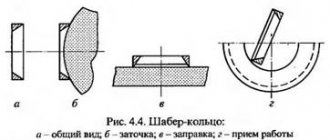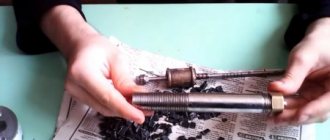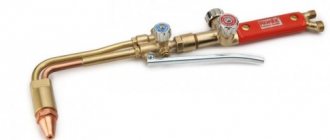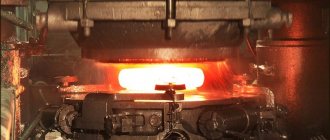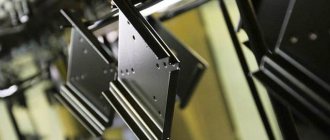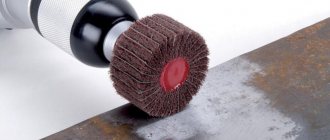Stamping as a technological process for processing blanks made of metal makes it possible to obtain finished products of a flat or volumetric type, differing in both their shape and size. When performing stamping, a working tool can be a stamp mounted on a press or other type of equipment. Depending on the conditions of execution, metal stamping can be hot or cold. These two types of this technology require the use of different equipment and compliance with certain technological standards.
Stamping – plastic deformation of metal, changing the shape or size of the material
Features of the technology
In addition to the division into hot and cold, stamping of metal products is also divided into a number of other categories depending on its purpose and technological conditions. Thus, stamping operations, as a result of which a part of the metal workpiece is separated, are called separation operations. This, in particular, includes cutting, chopping and punching metal parts.
Another category of such operations, as a result of which the stamped sheet of metal changes its shape, is form-changing stamping operations, often called forming. As a result of their implementation, metal parts can be subjected to drawing, cold extrusion, bending and other processing procedures.
As noted above, there are types of stamping, such as cold and hot, which, although implemented according to the same principle, which involves deformation of the metal, have a number of significant differences. Stamping of parts, which involves preheating them to a certain temperature, is used mainly in large manufacturing enterprises.
This is primarily due to the rather high complexity of such a technological operation, for the high-quality implementation of which it is necessary to make a preliminary calculation and accurately observe the degree of heating of the workpiece being processed. Using hot stamping, sheet metal of various thicknesses is used to produce critical parts such as boiler bottoms and other hemispherical products, hulls and other elements used in shipbuilding.
Characteristics and types of parts produced on hot stamping presses
To heat metal parts before hot stamping, heating equipment is used, which is able to provide precise temperature conditions. Electrical, plasma and other heating devices may be used in particular for this function. Before starting hot stamping, it is necessary not only to calculate the heating rates of the parts being processed, but also to develop an accurate and detailed drawing of the finished product, which will take into account the shrinkage of the cooling metal.
When performing cold stamping of metal parts, the process of forming the finished product occurs only due to the pressure exerted by the working elements of the press on the workpiece. Due to the fact that the blanks are not preheated during cold stamping, they are not subject to shrinkage. This allows us to produce finished products that do not require further mechanical modification. That is why this technology is considered not only a more convenient, but also a cost-effective processing option.
If you skillfully approach the issues of designing the size and shape of workpieces and the subsequent cutting of the material, you can significantly reduce its consumption, which is especially important for enterprises that produce their products in large batches. The material from which workpieces are successfully stamped can be not only carbon or alloy steels, but also aluminum and copper alloys. Moreover, an appropriately equipped stamping press is successfully used for processing workpieces made of materials such as rubber, leather, cardboard, and polymer alloys.
Separation stamping, the purpose of which is to separate a part of the metal from the workpiece being processed, is a very common technological operation used in almost every manufacturing enterprise. Such operations, which are performed using a special tool mounted on a stamping press, include cutting, punching and punching.
During the cutting process, metal parts are separated into separate parts, and such separation can be carried out along a straight or curved cutting line. Various devices can be used to perform cutting: disc and vibrating machines, guillotine shears, etc. Cutting is most often used to cut metal workpieces for further processing.
Punching is a technological operation during which parts with a closed contour are obtained from a metal sheet. Using punching, holes of various configurations are made in sheet metal blanks. Each of these technological operations must be carefully planned and prepared so that the result is a high-quality finished product. In particular, the geometric parameters of the tool used must be accurately calculated.
Technological stamping operations, during which the initial configuration of metal parts is changed, are forming, bending, drawing, flanging and crimping. Bending is the most common form-changing operation, during which bending areas are formed on the surface of a metal workpiece.
Drawing is a volumetric stamping, the purpose of which is to obtain a volumetric product from a flat metal part. It is with the help of drawing that a metal sheet is transformed into products of a cylindrical, conical, hemispherical or box-shaped configuration.
Along the contour of sheet metal products, as well as around the holes that are made in them, it is often necessary to form a side. Flanging successfully copes with this task. The ends of the pipes on which flanges need to be installed are also subjected to this treatment, performed using a special tool.
With the help of crimping, unlike flanging, the ends of pipes or the edges of cavities in sheet metal blanks are not expanded, but narrowed. When performing such an operation, carried out using a special conical matrix, external compression of the sheet metal occurs. Molding, which is also one of the types of stamping, involves changing the shape of individual elements of a stamped part, while the outer contour of the part remains unchanged.
Volumetric stamping, which can be performed using various technologies, requires not only careful preliminary calculations and the development of complex drawings, but also the use of specially manufactured equipment, so implementing such technology at home is problematic.
History of the process
It has been known and used since ancient times, since it was invented before the Middle Ages and even then allowed our ancestors to make weapons, jewelry and other things needed in everyday life. It has been steadily improved over the centuries, always distinguished by its comparative simplicity and high productivity, but it was performed manually until the 1850s, after which the level of technological development allowed it to be mechanized in earnest.
From the middle of the 19th century, technical operations began to be carried out on machine tools; from the beginning of the 20th, they began to produce car bodies; from the 1930s, the hulls and mechanisms of sea and river vessels and aircraft; from the 1950s, functional units and elements in rocket science.
Metal stamping has remained popular for centuries due to the following features and advantages:
- Versatility - it can be used to produce parts of any size and shape, both those that require further processing and those that are already ready for use.
- Precision manufacturing, especially at the current level of technology, which makes it possible to ensure the interchangeability of manufactured elements even without finishing.
- A penchant for mechanization and automation - high productivity has always been an obvious advantage, and today it is achieved through the use of rotary conveyor lines.
- Durability of final products, even thin, light, large ones.
The process is especially relevant for mass production - both small elements, like gears for watches, and large objects, for example, car bodies.
Areas of use
The method is in demand in various industries where it is necessary to give metals a given shape. The production of parts using stamping is used in the following areas:
- automotive industry;
- production of electronics, watches, etc.;
- construction;
- printing;
- mechanical engineering;
- aircraft manufacturing, etc.
Thanks to high-tech devices during the processing process, it is possible to obtain workpieces of a given shape of different sizes with a minimum of waste.
Making metal stamps
To make stampings from a workpiece, metal dies are constructed. At the first stage, drawings with specifications and details are developed.
Stamps consist of the following parts:
- The working parts are a punch and a matrix. Manufactured from tool steel U8a, U10a, X12M. After heat treatment, they are hardened to 60 Rockwell units.
- Punch holder. Material - Art. 3
- Gaskets. Manufactured from structural steel with a hardening grade of 45 Rockwell.
- Puller. Made from Art. 3
- Top and bottom plates. Their thickness depends on the force expended on stamping.
- Columns and bushings. The material is Steel 20. The surface is carburized to a depth of 1–1.5 mm. This layer is then hardened.
- Shank. Inserted into the press slide.
Equipment and tools
To equip an enterprise, a variety of tools are needed, starting from a simple cutting stamp. Such an element is a set of dies and punches plus additional parts. The upper and lower plates, guide columns and bushings perform the function of support and set the direction of the working parts. But the device varies, depending on the principle of operation of the stamp. Tools can be simple or single-operational, sequential or combined action - from two operations or more.
Cold sheet stamping is performed on crank presses. They are also presented in several types, depending on the number and types of operations performed. Hydraulic presses are installed to perform both cold and hot stamping. They can process thick sheets. The products are deep drawn.
Innovation is used to improve production processes. Stamping is accelerated by devices that feed a strip or tape into the die. Special devices for gripping and feeding workpieces simplify the production of piece products.
If the method is used in a small enterprise, the use of presses may be inappropriate from an economic point of view. Then special installations are used for small-scale production of parts.
element in the smithy
In order for stamping to be not only efficient, but also safe, innovative solutions are being introduced. For example, for the cold method, so-called hand releasers are in demand. These are devices that prevent employee injuries. In the danger zone, close to the die, devices prevent people's hands from falling under the press. Such mechanisms operate simultaneously with the movement of the press slide.
In some plants, the process is safe thanks to an even simpler solution. Hands cannot get under the press, since they must simultaneously press two start buttons. Photocells are also used to monitor the danger zone. They stop the press slide if hands are caught in the beams.
With the development of production methods, lines are automated, eliminating human participation. Automatic machines and industrial robots cope with tasks of varying levels of complexity.
The Cherepovets metal structures plant specializes in creating various metal products, therefore it is equipped with the latest technology. High qualifications and experience of specialists are two more components of successful cooperation with the enterprise.
Equipment according to GOST
There are the following types of machines:
- single crank;
- double crank;
- four-crank.
In any version, they are equipped with a steel matrix and a slider, which is connected to a stamp. The movement begins due to an electric motor, which contains elements of a kinematic chain. To free the worker's hands, the launch is done with the foot; there is a pedal at the bottom, which is connected to the rotation clutch. Next, the force is transferred to all moving elements, the process of metal stamping begins, as you understand, you cannot make such a technologically difficult machine with your own hands.
For complex products
The structure described above is suitable for the most basic workpieces. If the shape has a more complex configuration, a pneumatic press with two or three sliders is used. This is required for more durable fixation of the sheet, as well as for controlling several matrices at once. If the material is very strong and no press can “take” it, then they use an innovative development - an explosion. Its strength helps to penetrate even the strongest alloys.
Custom metal stamping process
Stamping of parts is the process of deforming metal to give a given shape and size to a part. Depending on the purpose of the part, we perform sheet and volumetric stamping. The main elements of stamped parts according to GOST 17040-80:
- flanging - deformation of the mold during which a bead is obtained along the outer edge or along the edge of the hole. There are the following types: normal (at an angle of 90°), at an angle of 60°, disc-shaped;
- bend—on the created sheet part along the selected edge, bending is performed in the selected radius and type of edge offset;
- extrusion is a change in the shape of a part, during which a blind depression or rift is obtained (a long shallow depression, the ends of which do not extend beyond the edge of the part).
Hot stamping on presses
Hot stamping of metal is also carried out on crank presses. The main characteristic of the equipment is the force it develops, varying from 6 to 110 MN.
Hot stamping on presses
The design of the crank hot stamping press has a rigid drive and does not make it possible to regulate the press stroke and its force. These factors exclude broaching and rolling from the list of permissible operations, since they require gradually increasing pressure.
The absence of impacts, the constant stroke of the die and the use of guides eliminates shifting, which makes it possible to achieve precision processing that is fundamentally unattainable with hammers.
Accordingly, it is possible to set significantly smaller tolerances, stamping radii and slopes, which reduces material losses and increases equipment productivity.
In addition, static deformation penetrates deeper into the blank than dynamic deformation, and this makes materials with low ductility accessible for processing.
The negative features of crank hot stamping presses are:
- scale is pressed into the surface; to combat this, heating in an inert atmosphere or deep cleaning of the blank is used;
- Due to prolonged contact with the punch, the blank cools down, its ductility and fillability decrease.
Technology and types of stamping
The technology of stamping metal structures using hot or cold methods requires the presence of equipment. For these types, stamps are used that differ from each other in a certain way. They are used for metal structures of various thicknesses.
Products of large dimensions are first heated and then subjected to forging. When cold, the thickness of the product usually does not exceed 1 mm. Various operations can be carried out with the material, for example, stamping badges.
There are different stamping methods. Here are some of them:
1. Cold stamping.
The cold stamping process does not involve heating the sheet material. The forces of the press are quite sufficient to carry out shaping and separation operations. As a result of cold stamping, a product is obtained that is not subject to the shrinkage process. For more economical consumption of material, stamping is carried out according to the rules for cutting sheets that comply with state standards.
Cold stamping processes include the following:
- Punching. In this process, the finished part goes into a container, and the waste remains outside. When punching, everything happens exactly the opposite: the waste goes into the container, and the part goes outside. The designs of both stamps are the same. During the work, a separation operation is carried out, which involves a die matrix and a punch.
- Bending is a simple operation. The product is placed between the stops on the matrix and pressed from above with a punch.
- Hood. The process occurs in several transitions and requires the manufacture of separate dies. During the work, a glass, hemisphere or cone is obtained from a round workpiece. This occurs due to the redistribution of metal in the original workpiece.
- Beading. The punch beads using a clamp: it catches a hole in the product and expands it.
One of the most important points in cold stamping is the choice of clearance between the punch and the die. The size depends on the thickness and type of material. The greater the thickness of the metal, the larger the gap. This value decreases for soft materials such as aluminum. Otherwise, burrs may appear.
Advantages of cold stamping:
- ample opportunities for automation and mechanization of the process;
- low production costs;
- high material utilization rate;
- when producing parts with thin walls, the strength of the metal structure is not reduced;
- eliminates the need for finishing processing of finished products.
2. Hot stamping.
The method of hot metal stamping involves pressing the workpiece under the influence of high temperatures and introducing them into a heating chamber. Stamping of bulk metal begins after the temperature reaches 1200 degrees. Hot blanks are placed in a die, where there are special grooves for preliminary and final stamping.
If it is necessary to upset a heated forging, you will have to place it in the space between two flat strikers. The equipment begins its work, and the product takes on the desired size.
There is also hot metal stamping. This option involves plastic deformation along three planes at once. Stamping allows you to make more complex workpieces. During operation, the part is exposed to pressure and high temperatures. The stamping process includes the following procedures:
- choice of stamp for metal;
- creation of the most detailed drawing;
- calculation of the number of technological transitions;
- preparation of documents for each intermediate stage;
- selection of suitable molds;
- setting the characteristics and heating modes of the workpiece;
- specifying the necessary finishing procedures.
3. Separation stamping.
This procedure becomes necessary when you need to obtain only a part of the workpiece being processed. It may include cutting, punching, and punching operations. Either one of them or several at once. They are performed using equipment placed on the press. You can choose scissors, a guillotine, a circular saw or a vibrating head as a tool. The trajectory of movement can be straight or broken. The main task is to obtain a product of the desired shape and with the desired contour.
4. Alternative stamping methods .
Metal stamping can be carried out not only by hot or cold methods. It occurs under the influence of other forces:
- Explosion. This procedure is carried out in water. In this case, the materials are located on a matrix where a recess of the required shape is made. An explosion is created from above, as a result of which the workpiece fills the stream and takes on the desired shape.
- Electrohydraulic stamping. Voltage is applied to the water and the liquid heats up. Due to high temperatures, a shock wave occurs, which forms the workpiece.
- Pulling metal through rolls. This method makes it possible to give the workpiece an optimal shape.
Sheet stamping of parts
This process is divided into two main components:
- separation, that is, separation of excess material from the part;
- shaping, that is, creating the shape of a part.
Stamping sheet metal parts is very simple. A press having the desired shape is lowered onto the workpiece under enormous pressure, after which the material is deformed from mechanical loads and receives the desired shape. The technology is widespread in the production of tractors, airplanes, cars, rockets, as well as in the manufacture of various equipment.
Part after stamping
Volumetric
A very interesting option, in which, due to plastic deformation along three planes at once, simple workpieces are made into more complex ones. It has a high degree of promise and is classified into two groups – with and without a change in the aggregate state of the product. Let's look at both in order.
GOSH technology – hot stamping of metal products
The part is subjected to pressure and, at the same time, temperature, heating in a closed mold without gaps. This cavity received two names at once - “stream” and, according to another version, “engraving”. Yes, at the initial stage of implementation, the method requires increased attention to the preparation of the base material, but it is good for its accuracy of matching the finished element to the given dimensions and the high quality of its surfaces, and this with a low percentage of flash.
The relative disadvantage is that the working equipment in this case is relatively expensive, and the operator requires additional training, but such expenditure of time and money pays off many times over in the long run of production.
The GOSH process can be roughly divided into 7 stages:
- choosing the type of metal stamp;
- creating a drawing that is as detailed as possible;
- calculation of the number of technological transitions to be performed;
- preparation of design documentation for each of the intermediate stages;
- determination of suitable molds;
- setting the main parameters and heating mode of the workpiece;
- specifying the necessary finishing procedures (taking into account the operational requirements for the finished product).
In addition, economists need to find the cost per unit of production produced according to the agreed algorithm.
Compared to hot forging, GOSH is much more accurate, it has better performance and it gives more options for achieving results, so it is objectively more promising.
In closed stamps
The die cavity is closed during deformation, so the gap between the moving and stationary zones is minimal. The design features of a closed stamp determine the type of stamping machine.
In most cases, the upper part of the die is characterized by a protrusion, and the lower part is a cavity. The opposite situation can also be encountered.
The use of such products in practice must be carried out with careful preparation and strict control over the identity of the volumes of the forging and the workpiece.
Problems may also arise with the height of the forging when working with the hot method: if there is too much metal, the height of the forging will be greater than planned. In order for stamping to take place according to the optimal pattern, it is important to cut the workpieces with maximum precision.
In open dies with variable clearance
A certain volume of metal flows into it, which makes it possible to fill the working cavity of the forging completely. In addition, the flash will be filled with excess metal at the final stage of work, which will reduce the requirement for the accuracy of workpieces by weight.
Cold and hot stamping using such products is carried out in four stages: upsetting the workpiece, aligning the walls of the product with the workpiece, excess metal flowing into the groove during compression, and removing excess metal from the cavity.
The advantage of hot stamping dies is the ability to produce any type of forgings.
Closed dies also have certain advantages:
- More favorable forging structure. In this case, there is no cutting of the fibers into a flash at the point of metal leakage. They flow around the forging contour, which makes it possible to achieve unique surface precision of parts without any types of grinding;
- No flash with this scheme. This allows you to significantly reduce metal consumption.
- The ability to work with low-plasticity alloys characterized by a high level of deformation under high stress of uneven all-round compression.
Additional operations
At the final stage, after removing excess material in the finishing stream, the shape of the part is corrected. This is required to correct its curved axes. Products made of alloy steels and large sizes are processed in a hot state. Small caliber products are adjusted after heat treatment and cooling.
The physical properties are brought to the required values during the final heating. Heat treatment relieves residual stress, reduces grain size and increases ductility.
Cleaning from scale is carried out by mechanical processing. The procedure for large products takes place in shot blasting complexes. Small parts are cleaned in tumbling drums.
Product calibration is used to reduce roughness and obtain accurate dimensions. After this, there is no need to carry out finishing processing; it is enough to sand the resulting parts. For the work, special dies with particularly precise grooves that repeat the configuration of the forging are used.
Advantages and disadvantages of hot stamping
Advantages:
- Saving metal by reducing losses.
- Possibility of manufacturing parts of complex shapes.
- Reduced labor intensity.
- Obtaining products of precise shape and configuration.
- High level of productivity.
The disadvantages of the method include:
- High cost of design and manufacturing of equipment.
- Complexity and energy intensity of the process.
- The maximum weight does not exceed 4 tons.
The hot method is used to produce large series and in cases where the complexity of the shapes and thickness of the products does not allow cold stamping.
Liquid stamping
The second name, injection molding, is not used very often, since it is expensive and also technologically difficult. But to obtain very durable products, without creases and possible inaccuracies, this particular method is used. It involves melting a metal alloy and then pouring it into a special stamping mold. After cooling, repeated stamping may occur, but as a final feature.
Cold metal stamping
It is effective and therefore one of the most common methods of manufacturing products. This processing method makes it possible to produce stamped parts of high precision and quality with minimal electrical energy consumption. The method helps to produce strong and lightweight metal structures using a small amount of raw materials. A type of cold stamping of sheet metal is flanging - creating a bead by bending an edge.
Sheet stamping
Parts using this method are produced by pressing metal sheets, strips or rolls. The thickness of the resulting product does not exceed 10 mm. Sheet metal stamping is in demand for mass production of products that are absolutely identical in shape and size.
Two types of presses are used to carry out the work:
- Universal. They are designed for cutting, bending and drawing.
- Special. With their help, deep drawing and specific bending of parts is carried out.
Sheet metal stamping can be carried out using mechanized equipment or automatic presses.
Workpieces for work are cut, if necessary, using mechanical or hydraulic shears. Wide sheets are cut on disc tools with cylindrical legs. The curved contour is made with disk or conical scissors.
Pros and cons of the method
The disadvantages of cold sheet metal stamping include the high cost of equipment. The process pays off quickly only in mass production.
The advantages of this method are:
- Ability to perform multiple operations in parallel.
- Obtaining interchangeable parts.
- Increased productivity and efficiency.
- Cost-effectiveness of mass and serial production.
- Obtaining durable parts while maintaining their minimum weight.
- Dimensional accuracy and high surface quality.
Cold stamping is designed to produce products weighing no more than 1 ton. Production of heavier weight products is not recommended.
Volumetric cold stamping
This universal method is in demand in the production of a variety of metal products. There are several types of volumetric stamping.
Separation stamping
In fact, this is cutting, punching and cutting. That is, here the material does not bend, but only the excess part is cut off from it. Various patterns and geometric shapes can be produced. This can be either the primary processing of the workpiece, and then the formation of volumes will occur, or the only step necessary for the finished product. Cutting is performed using special tools - knives made of high-strength and well-sharpened steel. The procedure can be either straight or curved. Apply:
- guillotine shears;
- vibration machines;
- disks.
This procedure can also be called cutting, a term used by tailors who cut prepared fabric in similar ways.
Stamping schemes
The specific configuration of hot die forging is selected by an experienced technologist, taking into account the following parameters:
- Part dimensions.
- Material.
- Form.
- Available equipment.
- Limits on labor intensity and material costs.
Currently, two main hot stamping schemes are used:
- with open stamp;
- with closed stamp.
Stamping in a closed die is carried out with a small gap between its halves. It is assumed that the volumes of the blank and the final part exactly match. Sometimes two adjoining lines are made, located at an angle to each other. The scheme is used for molding forgings with relatively simple configurations and makes it possible to achieve the greatest homogeneity of the internal structure of the part and less roughness.
Scheme of stamping in closed dies
When using the hot die forging scheme in open dies, there is no correspondence between the volumes of the blank and the final product, and an active redistribution of the metal mass between its parts occurs. Some of the metal is squeezed out of the die into a groove adapted for this purpose and is called flash. The scheme allows you to stamp parts of almost any configuration, since it allows you to carry out a large number of roughing and finishing passes with intermediate turns of the blank.
The essence and purpose of cold stamping of sheet metal
Cold stamping is the most popular technology for manufacturing various parts from metal and polymers. The versatility of the method lies in the fact that it allows the production of structures of any size: from kitchen utensils to elements of large ships.
Cold sheet plastic deformation is valued for the following advantages:
- Unlimited possibilities for mechanization and automation of the process.
- Low production costs.
- High material utilization rate.
- When manufacturing thin-walled elements, the strength of the structure is not reduced.
- There is no need for finishing processing of finished products.
High quality and manufacturability have a downside: setting up equipment requires qualified specialists. In addition, process design is a labor-intensive operation.
Cold stamping operations
Any working operation of sheet stamping can be classified as a group of separating or forming actions. Let's look at the basic procedures:
- Cutting. The operation involves cutting the material along a straight or complex line. Various types of scissors or guillotines are used as working equipment. Cutting can be performed both at the initial and final stages of production.
- Punching. Obtaining a hole of arbitrary shape.
- Felling. Cutting a structure along a closed contour. In this case, the separated part is a part, and not waste, as with punching.
- Beading. The operation of creating a side along an external or internal contour. Most often, the procedure is carried out at the end of the pipes, at the places where flanges are installed.
- Hood. Transformation of a flat product into a hollow volumetric part. The process may be accompanied by a change in wall thickness.
- Crimping Reducing the size of the end part by compression in a conical matrix.
- Flexible. Giving a curved configuration to flat parts. The most common are V- and U-shaped bending.
- Molding. Changing the local shape of a part while maintaining the dimensions of the outer contour.
History of the process
Stamping of metal products dates back to the 16th century. The need for this process arose due to the development of weapons production, which required the production of a large number of identical products. In the 19th century, the active development of stamping production began. They began to produce household utensils, and there was also a need for serial production.
With the advent of automobile and shipbuilding, metal stamping played an important role in the development of these industries. This process made it possible to produce products of large dimensions.
Classification of equipment for stamping metal products
In the most general case, it is a press machine with a certain type of drive (about which below), as well as various characteristics of strength, productivity, number of operations performed, maximum size of processed objects, and so on.
The choice must be made depending on the characteristics of production and on what kind of final product should be obtained: taking into account that relatively soft materials do not require significant power, that high speed is required for serial production, and other nuances of a particular case.
It is simply necessary that the machine model complies with the recommendations of current interstate standards. In addition to the operating parameters of equipment for sheet metal stamping, GOSTs also determine consumption, labor safety standards, design rules and other related issues.
Crank presses
The principle of operation of the equipment is based on the conversion of torque by a crank mechanism into reciprocating movement of the slider.
Hydraulic presses
The most powerful equipment, capable of developing a force of up to 2 thousand tons. The operating principle is based on the movement of two hydraulic cylinders of different diameters. The magnitude of the difference in size determines the degree of impact on the surface. The liquid is driven by special electrically driven pumps.
Radial forging presses
They are a molding press for the production of cylindrical parts. The machine is equipped with an induction furnace for preheating the ingots.
The equipment is used to produce forgings of square, round or rectangular cross-section.
Electromagnetic presses
A product of modern technology. The driving force is the energy of the electromagnetic field, which presses on the core with the wire winding. During the movement, it affects the executive part of the machine.
Hot stamping with hammers
The technology uses the phenomenon of converting the kinetic energy of a falling massive hammer into the energy of impact deformation of the workpiece. Hammers are raised to their original state by compressed air or steam and have a mass of 0.5 to 25 tons.
Hot stamping with hammers
By changing the height of the hammer, you can adjust the impact force. The stroke of the hammer is also adjustable, this makes it possible to rotate the workpiece during the next lifting of the hammer and more accurate stamping. All preparatory operations are available, including broaching and rolling.
The accuracy of manufacturing parts using hammers leaves much to be desired, which is explained by the inevitable shift of parts of the die relative to each other at the moment of impact. Tolerances when using hammers have to be given large, and to ensure the possibility of removing products from the press, large stamping slopes are made.
Automatic stamping lines
These are advanced and multifunctional complexes, equipped with CNC systems, with clear and easy-to-use touch screens. They have everything to minimize operator work, completely eliminate errors caused by the “human factor,” and ensure high labor productivity. The only BUT: they must function strictly according to the algorithm specified by an experienced process engineer.
We examined in detail all the main and popular equipment options and tried to clearly show the advantages and disadvantages of each of them. For more detailed advice, please contact our managers: they will help you select a machine to put the type of stamping you need into production.




